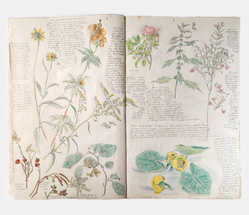(Page 3 of 3) Print Version
Letter to John Winthrop, circa 1645
Ink on paper
Collections of Maine Historical Society
MaineMemory.Net #126358
Staff Member: Gail Dodge, Museum & Digital Technician
This letter demonstrates secretary hand, a script used from the late 15th
century to the mid-17th century to help standardize writing and make
correspondence or recordkeeping easier. Often used by secretaries
to write official documents and correspondence, the letters, words,
and spellings are somewhat like modern English, but difficult to read.
Several examples of secretary hand are found in Coll. 60, the Plymouth
Company records, also known as the Kennebec Proprietors, which
relates to colonial settlement along the Kennebec River.
Gail recently digitized Coll. 60 as part of MHS’s Beyond Borders project.
This document, and others like it, stood out because of their llegibility.
While resembling a different language, they actually represent the
preferred way of writing official documents and correspondence in
the 1600s. This particular document includes an historic transcription
below the original script, making it especially unique.
Wadsworth-Longfellow House sign, 1901
Reproduction ink on paper
Collections of the Maine Historical Society
MaineMemory.Net #16153
Staff Member: John Babin, Visitor Services Manager
Ann Longfellow Pierce, Henry Wadsworth Longfellow’s sister, donated
their childhood home to Maine Historical Society upon her death in
1901. This sign hung outside the House, advertising tours after the
building opened to the public.
John came across this sign while researching the House and garden.
Being the front-line of MHS’s visitor services department, he found this
especially relevant since he still enjoys welcoming visitors over 120 years
later. MHS still exhibits, in his opinion, the world’s best collection of
Longfellow’s family belongings!
Summer & Early Autumn Sketchbook, Kennebunk, circa 1900
William Edward Barry (1846-1932)
Reproduction graphite on paper
Collections of the Maine Historical Society
1992.94.1
Staff Member: Steve Landry, Facilities Manager
An architect by profession, William Edward Barry created several field
sketchbooks featuring New England plants and wildlife. This page is
one example of his detailed artistry. Originally from Kennebunk, Barry
designed summer cottages, combining shingle, colonial revival and
Queen Anne styles. In addition to two botanical scrapbooks, MHS
houses Barry’s drawings featuring furniture and architectural elements.
Steve came across Barry’s work while planning a small pop-up exhibit
focused on botany collections. Steve was impressed with Barry’s
attention to detail and found his work to be a fantastic example of a field
sketchbook. Steve also appreciates the thorough annotations and the
use of color to bring the sketches to life.
Leave Her to Heaven movie poster, 2020
Reproduction print
Collections of Maine Historical Society
2023.052
Staff Member: Steve Bromage, Executive Director
This poster heralds one of the first (and last) events commemorating
Maine’s Bicentennial. Based on Maine author Ben Ames William’s
book, the majority of the film noir classic Leave Her to Heaven is set at
a Northern Maine lakeside lodge. The film’s digitally-restored version
premiered at the Waterville Opera House in March 2020—just before
the world shut down due to COVID-19.
The film’s premier was the last public event Steve attended before
the pandemic. He loves film noir, and enjoys this movie all the more
because it is set in Maine. He’s also a fan of Williams’s books, which
often take place in the fictional village of Fraternity, Maine. He’s drawn
to the bold colors, the mysterious woman behind the sunglasses, and
the little glimpse of the lake over her shoulder. Steve recommends the
film as a “great Maine experience!”
Friendly URL: https://www.mainememory.net/exhibits/selectionsfromthecollections






